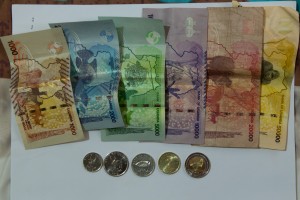 Matthias Heilke
Matthias Heilke
The stuff I have been working on the last couple weeks is a bit intense. Also, I already wrote a blog post about it for CEHURD, which you can (and totally should!) read here. So let’s talk about currency instead.
Uganda has a fairly annoying system of money to handle. The smallest bill is worth 1000/= (“/=” means “shillings”), which is the equivalent of about forty cents. The bills go up to 50,000/= ($20); they are all different colours, but the actual colour of a given denomination might vary depending on age, the 1000/= and 2000/= bills are often too dirty to see well, and anyway I’m colour-blind. Coins run from the diminutive 50/= to the two-piece 1000/=, though the 1000/= coin is less common than the 1000/= bill. The 100/= and 200/= coin are most common, and annoying to distinguish from each other — they’re just very slightly different sizes.

This is not a wealthy country. If I am walking down the street with 100,000/= ($40) in my pocket, I’m pretty loaded by local standards. Breaking a 50,000/= note is a chore. Any time I have to use the equivalent of a two-dollar bill to pay a fruit vendor, I know she will probably have to run into the nearest shop for change. One of my friends once used a 2,000/= bill (80¢) to pay a fruit vendor, and the vendor commented on what a large bill that is.
I bring this up because of what you don’t see on the street: the 50/= coin. Nobody ever prices anything, down to the tiniest piece of fruit, to divisions smaller than 100/=. In a place where the boda-boda drivers (which is a comparatively well-paying profession) will haggle endlessly over a 2000/= fare, nobody would think to worry about 50/=. And 50/= is worth twice as much as a penny.
I’m just saying, America.
